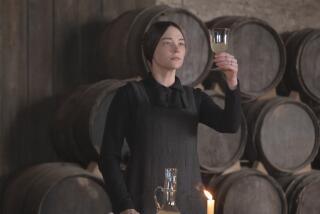Party for a Prized Asset : Labeling Regulations Are Honored
The French wine community gave a 50th anniversary party for a prized asset, its labeling regulations, Appellation d’Origine Controlee, which authenticates the name and origin for thousands of wines, including such famous names as Burgundy, Bordeaux and Champagne.
The regulations were feted with three days of auctions and seminars in Paris, culminating in a black-tie dinner at France’s Chateau de Versailles.
While the dinner was formal, and in my opinion superbly cooked and served by one of France’s greatest chef-caterers, Gaston Lenotre, the wines, as might otherwise be expected, were not well-known, credentialed, prestigious labels like first growth claret from Bordeaux or big-named Grand Crus from Burgundy.
Pierre Perromat, longtime chief of the Institute National des Appellations d’Origine, the organization charged with enforcing “AC,” explained that lesser known labels were selected more to show French depth of quality that the law ensures rather than focus on vintage superstars. He contends that his organization is as concerned with lesser wines from nondescript regions as it is with the famous varieties.
Unrecognizable Sources
Except for Armagnac, the wines were less than $10, with several at less than $5 even when they reach the United States. Over the three days approximately 300 appellations were served, almost all from unrecognizable place names such as Patrimonio and Ajaccio in Corsica and Menetou-Salon from the Loire.
At dinner, two whites stood out, Perves d’Or, Bourgogne Aligote, 1983 from the Domaine de Thevenot and Menetou-Salon, 1983, Jean Teiller. Aligote, a Burgundian white grape produces a quick to age, light, crisp white wine that is generally inexpensive and a best buy. The wine here made by Maurice Thevenot is in a clean, fresh crisp style without a long finish, designed more for quaffing than for savoring. Its production is similar to Muscadet, that is bottled on the lees without racking to retain freshness.
With consumers opting more for Chablis, Aligote has been largely overlooked in recent years. But that condition should change once they realize the less than $5 price tag. For Thevenot it is a triumph, as he was the first to replant in “Aligote Country,” Hautes Cotes de Nuits, after years of vine disease and economic strife.
Even better is Menetou Salon, Jean Teiller, 1984, with considerably more fragrance in the nose, more fruit and finish in a style not unlike a Sancerre or a delicate California Sauvignon Blanc. Produced from 10- to 15-year-old vines on clay and calcareous soil in a small vineyard of 20 acres, the wine, at less than $7, is most attractive if enjoyed young.
The red wines were equally low key. Domaine La Bernarde 1982 (Cuvee Saint Germain), a sprightly wine with appellation of Cotes de Provence, was upgraded to “AC” status in 1977. Characterized by a jammy strawberry-like flavor, it is soft and supple without tannin and an ability to age. The wines here are under a variety of different regional names these days, but no matter, the French still like to refer to them as Provence. The wines are about $5 and $6 and drinkable now.
The Minervois district, just north of Corbieres, about 60 miles from Toulouse, was represented by Domaine de Barroudio, 1984, Raymond Miguel showed a similar less jammy style but with more body. In a quaffing mode with more structure than most, this wine is truly one of “AC,” less expensive treats. Generally a blend of Carignane, Grenache Noir and Cinsault grapes, the name is derived from Minerve, one of the many strongholds of Rome during its reign in France. Many are available for $5 or less. Do not age the wine beyond two to three years.
Most appealing as a Rhone Valley generous red was Saint Joseph, 1983, Pierre Coursodon with soft, clean, accessible fruit and spice-like flavor. Frequently compared with its more noted regional neighbor, Hermitage, the wine shows more perfume in nose but less structure and body. Made from Syrah grapes, Saint Joseph wines may be a bit harder to find, but are likely to be at half the cost of Hermitage. Expect to pay around $5 to $8.
An excellent complement to the dinner’s cheese selections was a lesser known claret from the fabulous vintage of 1982. Exemplifying vintage characteristics of rich fullness and fatness, Chateau Mayne Blanc easily outdistanced the others in terms of assertive taste character and power.
The dinner concluded with France’s sweet fortified wines of Muscat and Frontignan. Exceptional is Muscat De Rivesaltes, SCA de Vins which showed a sharp Muscat nose and a generously sweet, long on the palate flavor derived from Muscat, Grenache and Malvoisie grapes. At 16% alcohol, this is a fortified wine that may not replace Port or Sherry, but at the price of $5 to $6 they are excellent dessert and aperitif contenders.
A similarly styled wine, Muscat de Beaunes de Venise, Caves des Vignerons, Phillipe Batigne, from the east side of the Rhone Valley exhibited more elegance and finesse and is a delightful meal finish. Made exclusively from the Muscat grape, its simple straight-forward one-dimensional flavorful style should please Muscat devotees.
For those who wanted to linger while contemplating the beauty of the chateau, two Armagnac brandies were offered, both with the title of “Hors d’Age,” which indicates they are at least 5 years of age. One of the Armagnacs, Hors d’Baron, vintage dated 1964, was exceptionally mellow and smooth. Unlike Cognac, Armagnacs can specify vintage years except when imported to the United States.
Armagnac, generally a brandy lover’s favorite, has never been as popular as Cognac. The latter is double distilled while Armagnac is produced in a continuous still, and as a consequence the aroma and taste of each is likely to be distinctively different. Armagnac is said to bring more fire and power to the glass, but not to the seductive complex aromas of Cognac.
The region is famous for D’Artagnan, the happy-go-lucky co-conspirator of the Three Musketeers, whose name often pops up on a label, “Reserve d’Artagnan,” designating a special Armagnac.
Meanwhile, at one of the anniversary lunches, two Corsican wines with the same appellation, Patrimonio; Patrimonio, Rouge, Clo Marfisi, 1983 and Rouge, 1984, Cooperative Vinicole were generously soft light styled red wines for immediate drinking. Generally the best of Patrimonio is rose, light, delicate and fresh. Nice wines for a brunch at less than $5.
The use of inexpensive unheralded appellations to celebrate “AC’s” anniversary was clever, an appropriate reminder to wine lovers everywhere that there still remains a host of French wine values undiscovered and untried. Today’s “AC” regulations represent an evolution of several centuries especially significant during periods when French vintners tried to expand exports.
The French like to say it is hard to get French vintners, especially of different regions, to agree on anything. But in 1935 they took a bold step in establishing regional wine controls over which grapes are to be grown, on minimum alcohol content, vine practices and maximum yields. Fifty years later the system is working to near perfection.
More to Read
Eat your way across L.A.
Get our weekly Tasting Notes newsletter for reviews, news and more.
You may occasionally receive promotional content from the Los Angeles Times.










